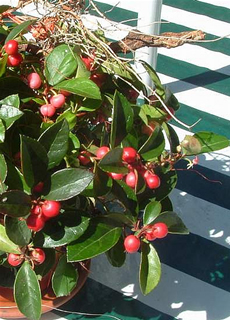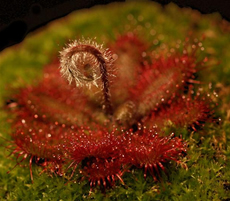Agriculture
Because plants are so biochemically diverse, they produce thousands of substances commonly referred to as secondary metabolites. Many of these secondary metabolites have medicinal properties that have proven to be beneficial to humankind.
The use of plants for medicinal purposes predates recorded history. Primitive people?s use of trial and error in their constant search for edible plants led them to discover plants containing substances that cause appetite suppression, stimulation, hallucinations, or other effects. Written records show that drugs such as opium have been in use for more than five thousand years.
From antiquity until fairly recent times, most physicianswere also botanists or at least herbalists. Because modern commercial medicines are marketed in neat packages, most people do not realize that many of these drugs were first extracted from plants.
Chemists have learned how to synthesize many natural products that were initially identified in a plant. However, in many cases a plant is still the only economically feasible source of the drug.
Antibacterial and Anti-inflammatory Agents
 The first effective antibacterial substance was carbolic acid, but the first truly plant-derived antibacterial drug was penicillin, which was extracted froma very primitive plant, the fungus Penicillium, in 1928. The success of penicillin led to the discovery of other fungal and bacterial compounds that have antibacterial activity. The most notable of these are cephalosporin and griseofulvin.
The first effective antibacterial substance was carbolic acid, but the first truly plant-derived antibacterial drug was penicillin, which was extracted froma very primitive plant, the fungus Penicillium, in 1928. The success of penicillin led to the discovery of other fungal and bacterial compounds that have antibacterial activity. The most notable of these are cephalosporin and griseofulvin.
Inflammation can be caused by mechanical or chemical damage, radiation, or foreign organisms. For centuries poultices of leaves from coriander (Coriandrum sativum), thornapple (Datura stramonium), wintergreen (Gaultheria procumbens), witch hazel (Hamamelis virginiana), and willow (Salix niger) were used to treat localized inflammation. In the seventeenth and eighteenth centuries, cinchona bark was used as a source of quinine, which could be taken internally.
In 1876 salicylic acid was obtained from the salicin produced by willow (Salix) leaves. Today, salicylic acid, also known as aspirin, and its derivatives, such as ibuprofen, are the most widely used anti-inflammatory drugs in the world.
Drugs Affecting the Reproductive System
A home remedy for preventing pregnancy was a tea made from the leaves of the Mexican plant zoapatle (Montana tomentosa). The drug zoapatanol and its derivatives were extracted from this plant to produce the first effective birth control substance. It has not been used in human trials, however, because of potential harmful side effects.
Other plant compounds that affect the reproductive system include diosgenin, extracted from Dioscorea species and used as a precursor for the progesterone used in birth control pills; gossypol from cotton (Gossypium species), which has been shown to be an effective birth control agent for males; ergometrine, extracted from the ergot fungus (Claviceps) and used to control postpartum bleeding; and yohimbine, from the African tree Corynanthe yohimbe, which apparently has some effect as an aphrodisiac. Circulatory, Analgesic, and Cancer-Fighting
Drugs
 Through the ages, dogbane (Apocynum cannabinum) and milkweed (Asclepias) have been prized for their effects on the circulatory system. These plants contain compounds calledcardiac glycosides. Foxglove (Digitalis) has produced the most useful cardiac glycosides, digitalis and digoxin.
Through the ages, dogbane (Apocynum cannabinum) and milkweed (Asclepias) have been prized for their effects on the circulatory system. These plants contain compounds calledcardiac glycosides. Foxglove (Digitalis) has produced the most useful cardiac glycosides, digitalis and digoxin.
Opiate alkaloids such as opium, extracted from a poppy (Papaver sonniferum), and its derivatives, such as morphine as well as cocaine, from Erythroxylum coca and Erythroxylum truxillense, have long been known for their analgesic (pain-relieving) properties through their extremely dangerous and addictive effects on the central nervous system.
The primary plant-derived anticancer agents are vincristine and vinblastine, extracted from Catheranthus roseus, maytansinoids from Maytentus serrata, ellipticine and related compounds from Ochrosia elliptica, and paclitaxel (commonly known as taxol) from the yew tree Taxus baccata.
Fighting Asthma, Gastrointestinal Disorders, Parasites
The major anti-asthma drugs come from ephedrine, extracted from the ma huang plant (Ephedra sinaica), and its structural derivatives. Plant-derived drugs that affect the gastrointestinal tract include castor oil, senna, and aloes as laxatives, opiate alkaloids as anti diarrheals, and ipecac from Cephaelis acuminata as an emetic.
The most useful plant-derived antiparasitic agent is quinine, derived from the bark of the chincona plant (Chincona succirubra). Quinine has been used to control malaria, a disease that has plagued humankind for centuries.
The Future
More plant-derived medicines await discovery, many from tropical rain-forest vegetation. Biotechnology has provided methods by which plants can be genetically modified to produce novel pharmaceuticals.
Progress toward the production of specific proteins in transgenic plants provides opportunities to produce large quantities of complex pharmaceuticals and other valuable products in traditional farm environments rather than in laboratories.
These novel strategies open up routes for production of a broad array of natural or nature-based products, ranging from foodstuffs with enhanced nutritive value to biopharmaceuticals.
- Biotechnology
BiotechnologyBiotechnology is the use of living organisms, or substances obtained from those organisms, to produce processes or products of value to humanity, such as foods, high-yield crops, and medicines. Modern biotechnological advances have provided...
- Paclitaxel
Also known by the brand name Taxol, paclitaxel is a potent cancer-fighting drug originally derived from the bark of the Pacific yew tree, a small- to medium-sized understory tree that occupies Pacific coastal forests from southwestern Alaska to California....
- The Amazing Health Benefits Of Turmeric
The active ingredient in turmeric is curcumin. Tumeric has been used for over 2500 years in India, where it was most likely first used as a dye. Aside from the holistic health community, Western medical practitioners have only recently come on board in...
- Mixing Grapefruit With Drugs Is Dangerous
The number of drugs when mixed with grapefruit that can lead to serious health problems, including sudden death, has skyrocketed, warns a Canadian researcher who first discovered the toxic link. In an article in the Canadian Medical Association Journal,...
- Medicinal Plant- Ocimum
Ocimum is a plant genus that has around 35 species. Ocimum is an aromatic herb or shrub of the family Lamiacea. Usually the leaves, stem or at times the entire herb in fresh as well as dry form are used for several medicinal and culinary purposes. I...
Agriculture
Medicinal Plants
 |
| Medicinal Plants |
The use of plants for medicinal purposes predates recorded history. Primitive people?s use of trial and error in their constant search for edible plants led them to discover plants containing substances that cause appetite suppression, stimulation, hallucinations, or other effects. Written records show that drugs such as opium have been in use for more than five thousand years.
From antiquity until fairly recent times, most physicianswere also botanists or at least herbalists. Because modern commercial medicines are marketed in neat packages, most people do not realize that many of these drugs were first extracted from plants.
Chemists have learned how to synthesize many natural products that were initially identified in a plant. However, in many cases a plant is still the only economically feasible source of the drug.
Antibacterial and Anti-inflammatory Agents

Inflammation can be caused by mechanical or chemical damage, radiation, or foreign organisms. For centuries poultices of leaves from coriander (Coriandrum sativum), thornapple (Datura stramonium), wintergreen (Gaultheria procumbens), witch hazel (Hamamelis virginiana), and willow (Salix niger) were used to treat localized inflammation. In the seventeenth and eighteenth centuries, cinchona bark was used as a source of quinine, which could be taken internally.
In 1876 salicylic acid was obtained from the salicin produced by willow (Salix) leaves. Today, salicylic acid, also known as aspirin, and its derivatives, such as ibuprofen, are the most widely used anti-inflammatory drugs in the world.
Drugs Affecting the Reproductive System
 |
| Mexican plant zoapatle (Montana tomentosa) |
Other plant compounds that affect the reproductive system include diosgenin, extracted from Dioscorea species and used as a precursor for the progesterone used in birth control pills; gossypol from cotton (Gossypium species), which has been shown to be an effective birth control agent for males; ergometrine, extracted from the ergot fungus (Claviceps) and used to control postpartum bleeding; and yohimbine, from the African tree Corynanthe yohimbe, which apparently has some effect as an aphrodisiac. Circulatory, Analgesic, and Cancer-Fighting
Drugs

Opiate alkaloids such as opium, extracted from a poppy (Papaver sonniferum), and its derivatives, such as morphine as well as cocaine, from Erythroxylum coca and Erythroxylum truxillense, have long been known for their analgesic (pain-relieving) properties through their extremely dangerous and addictive effects on the central nervous system.
The primary plant-derived anticancer agents are vincristine and vinblastine, extracted from Catheranthus roseus, maytansinoids from Maytentus serrata, ellipticine and related compounds from Ochrosia elliptica, and paclitaxel (commonly known as taxol) from the yew tree Taxus baccata.
Fighting Asthma, Gastrointestinal Disorders, Parasites
The major anti-asthma drugs come from ephedrine, extracted from the ma huang plant (Ephedra sinaica), and its structural derivatives. Plant-derived drugs that affect the gastrointestinal tract include castor oil, senna, and aloes as laxatives, opiate alkaloids as anti diarrheals, and ipecac from Cephaelis acuminata as an emetic.
 |
 |
The most useful plant-derived antiparasitic agent is quinine, derived from the bark of the chincona plant (Chincona succirubra). Quinine has been used to control malaria, a disease that has plagued humankind for centuries.
The Future
More plant-derived medicines await discovery, many from tropical rain-forest vegetation. Biotechnology has provided methods by which plants can be genetically modified to produce novel pharmaceuticals.
Progress toward the production of specific proteins in transgenic plants provides opportunities to produce large quantities of complex pharmaceuticals and other valuable products in traditional farm environments rather than in laboratories.
 |
| The complete grape growing system |
These novel strategies open up routes for production of a broad array of natural or nature-based products, ranging from foodstuffs with enhanced nutritive value to biopharmaceuticals.
- Biotechnology
BiotechnologyBiotechnology is the use of living organisms, or substances obtained from those organisms, to produce processes or products of value to humanity, such as foods, high-yield crops, and medicines. Modern biotechnological advances have provided...
- Paclitaxel
Also known by the brand name Taxol, paclitaxel is a potent cancer-fighting drug originally derived from the bark of the Pacific yew tree, a small- to medium-sized understory tree that occupies Pacific coastal forests from southwestern Alaska to California....
- The Amazing Health Benefits Of Turmeric
The active ingredient in turmeric is curcumin. Tumeric has been used for over 2500 years in India, where it was most likely first used as a dye. Aside from the holistic health community, Western medical practitioners have only recently come on board in...
- Mixing Grapefruit With Drugs Is Dangerous
The number of drugs when mixed with grapefruit that can lead to serious health problems, including sudden death, has skyrocketed, warns a Canadian researcher who first discovered the toxic link. In an article in the Canadian Medical Association Journal,...
- Medicinal Plant- Ocimum
Ocimum is a plant genus that has around 35 species. Ocimum is an aromatic herb or shrub of the family Lamiacea. Usually the leaves, stem or at times the entire herb in fresh as well as dry form are used for several medicinal and culinary purposes. I...


